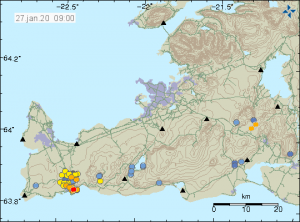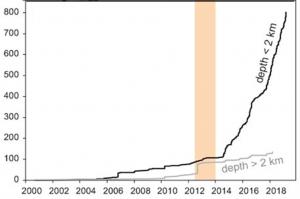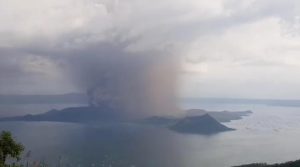 The Icelandic volcanologists of the Institute IMO express concern about the current situation on the Reykjanes Peninsula. In the vicinity of Grindavik, there have been repeated swarm quakes in recent months, which were quite strong. Since 21 January, GPS measurements now show a rise in the ground that has not been seen there for decades. Under the volcano Þorbjörn the ground is rising by 3-4 mm per day. This rise is caused by magmatic fluids rising under the volcano. In all probability it is magma that causes Þorbjörn to rise. As a result, the civil defence has declared the VONA warning level “yellow”. Residents of the area will be invited to an information meeting tomorrow. There they will be informed about how to prepare for a possible volcanic eruption.
The Icelandic volcanologists of the Institute IMO express concern about the current situation on the Reykjanes Peninsula. In the vicinity of Grindavik, there have been repeated swarm quakes in recent months, which were quite strong. Since 21 January, GPS measurements now show a rise in the ground that has not been seen there for decades. Under the volcano Þorbjörn the ground is rising by 3-4 mm per day. This rise is caused by magmatic fluids rising under the volcano. In all probability it is magma that causes Þorbjörn to rise. As a result, the civil defence has declared the VONA warning level “yellow”. Residents of the area will be invited to an information meeting tomorrow. There they will be informed about how to prepare for a possible volcanic eruption.
Eruptions
News about eruptions and volcanoes can be found in this category. It is updated frequently. Volcano expert and journalist Marc Szeglat reports live from his expeditions to volcanoes.
Campi Flegrei: Tremor amplitude increases
 While all eyes look at the Philippine Taal volcano, there is also something interesting going on under the European pedant Campi Flegrei. The INGV Napoli yesterday published a new report on the situation of the large caldera volcano, which can erupt at a similar rate as the Taal. The focus of the report is the thermal area around the fumarole of Pisciarelli , which is located on the north-western crater rim of the Solfatara. There one can observe an increase in the tremor amplitude. Although it is primarily a fumarolic tremor, which occurs at a depth of less than 1 km and is therefore in the area of the hydrothermal system, it also represents the overall state of the magmatic system of the caldera. The volcanologists see a correlation between changes in the geochemistry of the fluids, the soil deformation with peaks of 60 cm uplift and the fumarolic tremor. Therefore, it is quite possible that the Caldera volcano is slowly preparing for an eruption.
While all eyes look at the Philippine Taal volcano, there is also something interesting going on under the European pedant Campi Flegrei. The INGV Napoli yesterday published a new report on the situation of the large caldera volcano, which can erupt at a similar rate as the Taal. The focus of the report is the thermal area around the fumarole of Pisciarelli , which is located on the north-western crater rim of the Solfatara. There one can observe an increase in the tremor amplitude. Although it is primarily a fumarolic tremor, which occurs at a depth of less than 1 km and is therefore in the area of the hydrothermal system, it also represents the overall state of the magmatic system of the caldera. The volcanologists see a correlation between changes in the geochemistry of the fluids, the soil deformation with peaks of 60 cm uplift and the fumarolic tremor. Therefore, it is quite possible that the Caldera volcano is slowly preparing for an eruption.
Taal: Seismic high, SO2 low
 The situation on the Taal is still exciting. Yesterday and today the VAAC registered one ash cloud each, whose ascent heights could not be determined. The seismic activity is still high. The Taal network recorded 486 tremors in the last 24 hours. The strongest one had a magnitude of 2.7 and was not noticed by local residents. The seismic activity is probably caused by rising magma. The ground deformations are correspondingly large. Especially in the southwest and north of the caldera there are ground elevations which are probably related to the inflation of magmatic fluids. In the eastern part of the caldera, however, the ground has been sinking.
The situation on the Taal is still exciting. Yesterday and today the VAAC registered one ash cloud each, whose ascent heights could not be determined. The seismic activity is still high. The Taal network recorded 486 tremors in the last 24 hours. The strongest one had a magnitude of 2.7 and was not noticed by local residents. The seismic activity is probably caused by rising magma. The ground deformations are correspondingly large. Especially in the southwest and north of the caldera there are ground elevations which are probably related to the inflation of magmatic fluids. In the eastern part of the caldera, however, the ground has been sinking.
Sulphur dioxide emissions are disproportionately low, at only 224 tonnes per day. One would expect at least 10 times the current value. Philippine volcanologists speculate about plugs in the production vents that prevent the gas from escaping. However, such plugs would not only block the sulphur dioxide, but also impair the entire gas exchange. The result would be an enormous increase in pressure in the earth’s interior. Alternatively, the soil deformations could not be caused by magma, but by other fluids. Water would be one possibility. This would also be an answer to the question where the disappeared water of Lake Taal has gone: Last week the lake level dropped a few centimetres.
Etna: Summit activity continues
The activity of the volcano Etna on Sicily (Italy) continues and is even worth seeing, as the video below demonstrates. The intracrater cone of Voragine is strombolian active and continues to grow slowly. From a vent on the lower flank of the cone a lava flow is flowing, which splits into 2 arms. They flow into the neighbouring crater Bocca Nuova and form a rare lava fall there.
From the technical point of view the eruption manifests itself in an increased tremor and moderate thermal signals. MIROVA registered radiation with a power of 44 MW. In addition, the INGV thermal imaging camera now shows 2 hot spots in the area of the New South East Crater. It looks as if another vent has become active there.
Taal volcano erupted
On 12 January, the eruption began with phreatic explosions, which then increased rapidly. A violent eruption caused ash clouds to rise into the stratosphere. The eruptions manifested from the main crater of Volcano Island, which is located in the middle of the Taal caldera. The ash not only rained down in the immediate vicinity of the volcano, but even reached the capital Manila. The airport was closed.
In various places, house roofs collapsed, which could not withstand the weight of the ash. The following day, lateral vents opened on the flank of Volcano Island. These generate smaller eruptions. PHILVOLCS also reported short lava flows of highly viscous lava.
The eruption was announced by numerous earthquakes. Their frequency increased in the last weeks and reached peak values of 140 quakes per day. Shortly before the eruption the magnitude of the earthquakes increased and reached M 4.0.
The authorities reacted quickly and ordered evacuations. A 14 km long exclusion zone was established. It largely encloses the Taal Lake, which is located in the caldera.
Translated with www.DeepL.com/Translator (free version)
Etna: Activity increases
The activity on Etna in Sicily seems to be slightly increasing again. The LGS registered sounds that could be caused by explosive activity with its infrasonic microphones and issued an “early warning” of level yellow. Visual confirmation of the activity was provided in the form of images posted by Dr. Boris Behncke of the INGV. They are similar to what we last saw of the volcano in December. There is an active vent in the Voragine that supports glowing tephra. Small ash clouds rose from the New South East Crater and the Northeast Crater. MIROVA registers weak to moderate heat radiation. The tremor is normal.
Anak Krakatoa: New eruptions
The Indonesian island volcano Anak Krakatau continues to be explosively active and produces volcanic ash. The VAAC Darwin reports ash at 2400 m altitude. MIROVA recorded a weak thermal anomaly with a power of 3 MW and seismic activity is elevated. Unfortunately, there are no longer any usable LiveCam images, because the ash erupted yesterday has soiled the camera.
The VSI recorded 18 seismic signals caused by explosive eruptions. The longest lasted 62 minutes. Harmonic tremors were also recorded. Already at the beginning of the month the earthquakes increased with a low frequency and indicated that magma was moving underground. Further eruptions can be expected.
GAK erupsi, ini proses biasa & ttp tenang, jauhi dr rad 2km. Erupsi proses biasa, keluarkan material tanda aktif, bhw GAK sdg tumbuh. Saksikan fenomenanya adalah hal luar biasa. (Sumber HPI Banten).@vulkanologi_mbg @PRB_BNPB@Kemenpar_RI @infomitigasi
–https://t.co/AGvwXCX7qc pic.twitter.com/XXJEU5AAb2— widjokongko (@widjokongko) 31. Dezember 2019
The eruptions started on 29 December 2019, and initially the volcano increased its activity and erupted phreatic. In the evening, glowing tephra and volcanic ash was also produced.
Nevados de Chillan: Pyroclastic flow
The Chilean volcano Nevados de Chillan is very active and produces several explosive ash eruptions daily. The volcanic ash penetrates up to altitudes of 5000 m. At least one of these eruptions produced a small pyroclastic flow yesterday. After an explosion, it rushed down the northern slope of the volcano. The explosion emanated from the lava dome, which is called “Gil-Cruz”. The dome began to grow in January 2018. A few months later it was partially destroyed by a series of eruptions. Meanwhile it seems to have recovered well. SERNAGEOMIN keeps the VONA status on “orange”.
White Island: Dead during eruption
The New Zealand island volcano White Island lies in the bay of Plenty and erupted explosively. Volcanic ash rose to an altitude of 3600 m. The collapsing eruption cloud caused a pyroclastic flow that reached the sea.
The island volcano is a popular tourist attraction. From the coastal town of Whakatane, curious people take off by boat and helicopter to the volcano to see the numerous hydrothermal phenomena. Today at least 5 tourists died on the island, several people were injured. 23 people have been evacuated from the island so far. Most of them showed burns. Up to 27 people could still be on the volcano. Their fate is uncertain. According to media reports, a rescue team was still on its way in the evening, but was not allowed to enter the island because the danger of another eruption was too high.
There were about 100 people in the catchment area of the island when the eruption occurred at 14:11 local time. On video recordings you can see people covered with ashes waiting at the jetty for their boat. Many people only wore shorts and t-shirts. You can also see a destroyed helicopter that had dropped tourists on the island.
Etna: strombolian eruptions at NSEC
Last night Etna showed its strombolian side and produced further eruptions from the New South East Crater. Glowing tephra was ejected up to 100 m high, which was quite photogenic. At peak times MIROVA registered thermal radiation with a power of 144 MW.
This morning the activity seems to have decreased, MIROVA only registered a thermal anomaly of 36 MW power. In addition, the Thermalcam shows no more thermal radiation around the last active vent. But there seems to be more activity in the central crater. Possibly the small lava flow is still pouring into Bocca Nouva. It originated at the new intracrater cone of Voragine. The tremor is clearly increased and gives an indication that this activity is continuing. The video shows the status-quo on Friday.